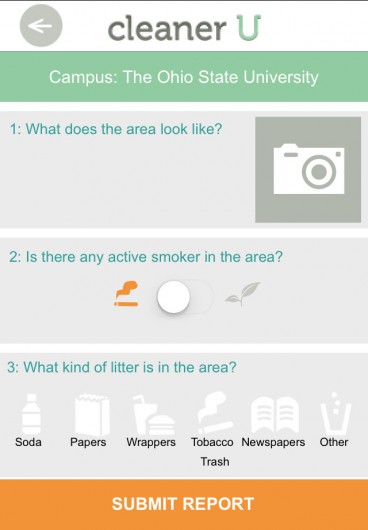A smartphone app allows users to report litter and smokers on Ohio State’s campus, but some staff and students said the app could take a while to help make the area cleaner.
OSU began an enforced campus-wide tobacco ban Jan. 1 on all tobacco products including cigarettes, tobacco chew, snuff and e-cigarettes.
The free app, CleanerU, was developed by a faculty member of OSU’s College of Public Health. It gives users the option of choosing whether their campus is clean or “can be cleaner,” then uploading a photo and noting whether there is an active smoker in the area, as well as what kind of litter is around. The location of where the picture was taken is automatically attached and placed on a map all users can browse.
Jonathan Nutt, assistant director and policy coordinator of OSU’s Student Wellness Center, said the main goal of the app is to build a healthier and more clean campus environment.
“(It’s) not just about tobacco smoke but litter or anything … like spray paint or any kind of other (issues) that might be on campus,” Nutt said in an interview with The Lantern Jan. 16.
Dr. Peter Shields, deputy director of the Wexner Medical Center James Comprehensive Cancer Center, said in an interview with The Lantern Jan. 16, though, photos of people, including smokers, aren’t supposed to be uploaded.
Some staff members said the app might help raise awareness of the tobacco ban.
Miroljub Ruzic, a subject specialist for East European and Slavic studies, religious studies and history of Christianity and modern Greek, said the app’s visual aid mechanism could boost awareness.
“People will become more conscious where they see (trash), and the feature of the photo attachment will show that the litter is actually there,” Ruzic said.
Some students agreed.
Erica Iles, a fifth-year in biology, said the app could help cut down on littering in general.
“Students at OSU want to take care of their campus and have it look nice, so I think the app will be useful for places … where there seems to be more garbage,” Iles said.
Other students are more skeptical about the app having a noticeable effect.
Hannah Gibbs, a first-year in neuroscience, said the app is a good idea, but might take some time to start having an impact.
“I just don’t know if people will actually avoid the parts of campus that are considered unclean according to the app, but hopefully with time they will,” Gibbs said.
Shields said the app is meant to guide OSU officials in the right direction when looking at how to make campus cleaner.
“We’re not gonna run to that spot, we’re going be tracking how many reports we get over there and then figure out how to deal with it. If it’s students (smoking or littering) we’ll deal with it, if it’s faculty or staff then we’ll deal with it,” Shields said.
OSU is spending money on preventative efforts in the meantime — it has spent about $43,000 of its $100,000 tobacco ban signage budget to make sure when visitors come to campus, they remember to put out their cigarettes. Signs have been placed outside several university buildings, including the Ohio Union, and banners have been hung in parking garages.
The money used comes from “benefit funds,” not a single department, and is administered on behalf of OSU by the Office of Human Resources, according to OSU spokesman Gary Lewis.
The campus-wide ban was announced in 2013, and was set to take effect Aug. 1. In August, however, university officials said the ban would not be enforced until 2014.
Shields said cleanup efforts won’t substantially change for now, but OSU staff will continue adapting to whatever efforts are necessary.
“I think that we end up responding to whatever needs (there are) … Hopefully over time we’re gonna see less butts,” Shields said.



